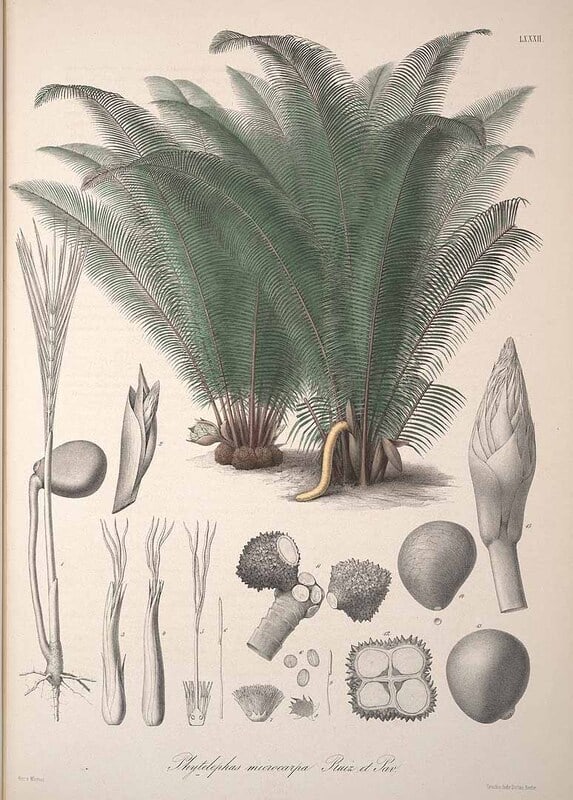
🌿 Morphology
🌞 Growing conditions
🌍 Origin and family
🌾 Uses
Warning: Despite the care taken in writing this sheet, it is essential to cross-reference sources before using or consuming any plant. When in doubt, consult a qualified professional
Permaculture uses
The primary permaculture use is the nuts, which yield a hard, ivory-like material used for buttons, carvings, and other sustainable alternatives to animal ivory. The palm's large leaves can provide shade and shelter. The fruits are also edible, and the plant can contribute to soil stabilization in erosion-prone areas. No specific subspecies or cultivars are especially noted for enhanced permaculture usage.
Permapeople description
Phytelephas macrocarpa is a palm native to northern South America. It is the source of vegetable ivory.
Botanical description
Phytelephas macrocarpa is a palm species native to tropical rainforests of northwestern South America. It's a slow-growing, dioecious palm, meaning male and female flowers are on separate plants. The trunk is usually short and often subterranean. The leaves are pinnate and can reach several meters in length. Female plants produce large, globose fruits containing multiple seeds, which are the source of vegetable ivory. These seeds mature slowly, requiring several years to reach full hardness.
Companion planting
As a large rainforest palm, Phytelephas macrocarpa benefits from the shaded, humid environment created by other trees. It can co-exist with various understory plants typical of its native habitat, but specific companion planting relationships are not well-documented. Avoid planting in areas prone to frost.
Propagation methods
Propagation is primarily achieved through seed. Seeds require a scarification or soaking pre-treatment to improve germination rates. Patience is required as germination can be slow and erratic. Vegetative propagation methods are not typically employed.
History and traditions
The indigenous peoples of South America have long utilized the vegetable ivory from Phytelephas macrocarpa for carving and ornamental purposes. The material gained international popularity in the 19th century as a substitute for animal ivory, particularly for button manufacturing and intricate carvings. It played a role in conservation efforts by reducing the demand for elephant ivory.
Usage calendar
Flowering occurs throughout the year, depending on the local climate. Fruit maturation takes several years. Harvesting of the fruits typically occurs during the dry season when they naturally fall from the palm. Seed planting is best done after scarification during the rainy season.
